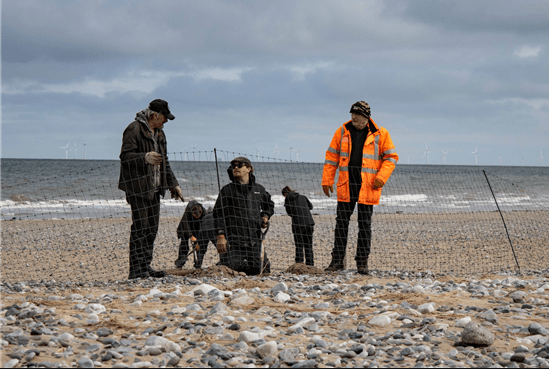As spring progresses, preparations are underway along the Denbighshire coast to welcome one of Wales’ most delicate and celebrated seasonal visitors.
With their arrival imminent, teams of conservation experts, volunteers, and council workers have begun constructing a protective compound to ensure these rare seabirds have a safe space to breed undisturbed.
Spanning 3.5km, a secure perimeter is being built along the Gronant sand dunes to protect Little Terns returning from West Africa.
As part of a long-term conservation initiative, this annual effort is vital for shielding the birds from potential threats throughout their vulnerable nesting period.
This year, the project includes 3km of electric fencing to establish 11 pens across the shingle ridge, designed specifically to deter both aerial and ground predators.
These preparations form part of a 20-year conservation mission aimed at preserving the fragile breeding success of Little Terns in Wales. Arriving between late April and early May, the birds nest in shallow scrapes, leaving their eggs susceptible to weather changes, tidal surges, and especially predators.
Back in 2005, crows were responsible for the loss of 60 eggs. A more severe incident occurred 12 years later when a fox gained access to the site after sandstorms created a gap beneath the fencing, resulting in the destruction of 160 eggs.
To maintain the natural integrity of the area, which is designated as a Site of Special Scientific Interest (SSSI), all fencing will be dismantled at the end of the breeding season. Meanwhile, a dedicated visitor centre and hide will be installed once again, allowing the public to observe the nesting birds without causing disruption.
“We maintain this set up at the location as the birds are very vulnerable to human disturbance and they are also at risk from predators both in the air and on the ground,” said North Denbighshire coastal ranger Claudia Smith.
“We’ll have a team of wardens at the visitors centre from early May to protect the birds, talk to visitors and collect information about this year’s colony.”
Gronant is home to Wales’ largest Little Tern breeding colony, with the only other site situated at Point of Ayr in Flintshire. In 2023, 166 breeding pairs were recorded, resulting in 158 fledglings — a slight increase from the previous year.
A highlight of the 2024 season was the successful fledging of two avocet chicks, a species once considered extinct in the UK.
Denbighshire Countryside Services, in collaboration with the North Wales Little Tern Group and the Merseyside Ringing Group, continue to oversee the site’s maintenance and security.
Volunteers are invited to assist with the fencing setup on the following dates:
- Tuesday, 15 April
- Thursday, 24 April
- Tuesday, 29 April
- Friday, 2 May
Support is also welcomed throughout the nesting season (May to August).
“None of this would be possible without the fantastic support of all the volunteers who have helped us over the last two decades,” added Claudia. Anyone interested in volunteering or planning a visit can contact Claudia Smith via email at [email protected] or by phone on 07785 517398.






